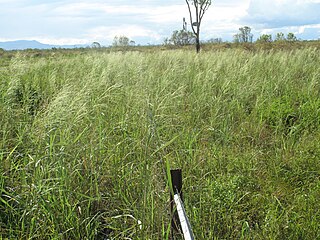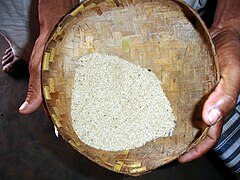
Rice is a cereal grain and in its domesticated form is the staple food of over half of the world's population, particularly in Asia and Africa. Rice is the seed of the grass species Oryza sativa —or, much less commonly, Oryza glaberrima. Asian rice was domesticated in China some 13,500 to 8,200 years ago; African rice was domesticated in Africa about 3,000 years ago. Rice has become commonplace in many cultures worldwide; in 2021, 787 million tons were produced, placing it fourth after sugarcane, maize, and wheat. Only some 8% of rice is traded internationally. China, India, and Indonesia are the largest consumers of rice. A substantial amount of the rice produced in developing nations is lost after harvest through factors such as poor transport and storage. Rice yields can be reduced by pests including insects, rodents, and birds, as well as by weeds, and by diseases such as rice blast. Traditional rice polycultures such as rice-duck farming, and modern integrated pest management seek to control damage from pests in a sustainable way.

The oat, sometimes called the common oat, is a species of cereal grain grown for its seed, which is known by the same name. Oats appear to have been domesticated as a secondary crop, as their seeds resembled those of other cereals closely enough for them to be included by early cultivators. Oats tolerate cold winters less well than cereals such as wheat, barley, and rye, but need less summer heat and more rain, making them important in areas such as Northwest Europe that have cool wet summers. They can tolerate low-nutrient and acid soils. Oats grow thickly and vigorously, allowing them to outcompete many weeds, and compared to other cereals are relatively free from diseases.

Introgression, also known as introgressive hybridization, in genetics is the transfer of genetic material from one species into the gene pool of another by the repeated backcrossing of an interspecific hybrid with one of its parent species. Introgression is a long-term process, even when artificial; it may take many hybrid generations before significant backcrossing occurs. This process is distinct from most forms of gene flow in that it occurs between two populations of different species, rather than two populations of the same species.

Oryza rufipogon is a species of flowering plant in the family Poaceae. It is known as brownbeard rice, wild rice, and red rice. In 1965, Oryza nivara was separated off from O. rufipogon. The separation has been questioned, and some sources consider O. nivara to be a synonym of O. rufipogon. O. nivara may be treated as the annual form of O. rufipogon.

Oryza longistaminata is a perennial species of grass from the same genus as cultivated rice. It is native to most of sub-Saharan Africa and Madagascar. It has been introduced into the United States, where it is often regarded as a noxious weed. Its common names are longstamen rice and red rice.

Aromatic rice is one of the major types of rice. It is a medium- to long-grained rice. It is known for its nutty aroma and taste, which is caused by the chemical compound 2-acetyl-1-pyrroline. Varieties of aromatic rice include Ambemohar, Basmati, Jasmine, Sona Masuri, Texmati, Tulaipanji, Tulshimala, Wehani, Kalijira, Chinigura, Gobindobhog, Kali Mooch and wild Pecan rice. When cooked, the grains have a light and fluffy texture except for Gobindobhog rice which is sticky in texture.

A crop wild relative (CWR) is a wild plant closely related to a domesticated plant. It may be a wild ancestor of the domesticated (cultivated) plant or another closely related taxon.

Oryza glaberrima, commonly known as African rice, is one of the two domesticated rice species. It was first domesticated and grown in West Africa around 3,000 years ago. In agriculture, it has largely been replaced by higher-yielding Asian rice, and the number of varieties grown is declining. It still persists, making up an estimated 20% of rice grown in West Africa. It is now rarely sold in West African markets, having been replaced by Asian strains.
Oryza nivara is a possible wild progenitor of the cultivated rice Oryza sativa. It was separated from Oryza rufipogon in 1965; however, the separation has been questioned, and some sources treat it as a synonym of O. rufipogon. It may be treated as the annual form of O. rufipogon.

Japonica rice, sometimes called sinica rice, is one of the two major domestic types of Asian rice varieties. Japonica rice is extensively cultivated and consumed in East Asia, whereas in most other regions indica rice is the dominant type of rice. Japonica rice originated from Central China, where it was first domesticated along the Yangtze River basin approximately 9,500 to 6,000 years ago.

Rice production in China is the amount of rice planted, grown, and harvested for consumption in the mainland of China.

Plant breeding is the science of changing the traits of plants in order to produce desired characteristics. It has been used to improve the quality of nutrition in products for humans and animals. The goals of plant breeding are to produce crop varieties that boast unique and superior traits for a variety of applications. The most frequently addressed agricultural traits are those related to biotic and abiotic stress tolerance, grain or biomass yield, end-use quality characteristics such as taste or the concentrations of specific biological molecules and ease of processing.
Plant breeding started with sedentary agriculture, particularly the domestication of the first agricultural plants, a practice which is estimated to date back 9,000 to 11,000 years. Initially, early human farmers selected food plants with particular desirable characteristics and used these as a seed source for subsequent generations, resulting in an accumulation of characteristics over time. In time however, experiments began with deliberate hybridization, the science and understanding of which was greatly enhanced by the work of Gregor Mendel. Mendel's work ultimately led to the new science of genetics. Modern plant breeding is applied genetics, but its scientific basis is broader, covering molecular biology, cytology, systematics, physiology, pathology, entomology, chemistry, and statistics (biometrics). It has also developed its own technology. Plant breeding efforts are divided into a number of different historical landmarks.

Rajeev Kumar Varshney is an Indian agricultural scientist, specializing in genomics, genetics, molecular breeding and capacity building in developing countries. Varshney is currently serving as Director, Western Australian State Agricultural Biotechnology Center; Director, Centre for Crop & Food Innovation; and International Chair in Agriculture & Food Security with the Food Futures Institute at Murdoch University, Australia since Feb 2022. Before joining Murdoch University, Australia he served International Crops Research Institute for the Semi-Arid Tropics (ICRISAT), a global agriculture R&D institute, for more than 16 years in different scientific and research leadership roles including Research Program Director for three global research programs– Grain Legumes, Genetic Gains and Accelerated Crop Improvement Program. He has the onus of establishing and nurturing the Center of Excellence in Genomics & Systems Biology (CEGSB), a globally recognized center for genomics research at ICRISAT that made impacts on improving agriculture and development of human resources in several countries including India, China, Kenya, Ethiopia, Tanzania, Nigeria, Ghana, Mali, Senegal, Burkina Faso, etc. Varshney holds Adjunct/Honorary/Visiting Professor positions at 10 academic institutions in Australia, China, Ghana, Hong Kong and India, including The University of Western Australia, University of Queensland, West Africa Centre for Crop Improvement, University of Hyderabad, Chaudhary Charan Singh University and Professor Jayashankar Telangana State Agricultural University.

Oryza australiensis is a wild rice species native to monsoonal northern Australia. Also known as Australian rice or Australian Wild Rice, it is a perennial plant that uses the C3 photosynthesis pathway. O. australiensis is unique among other Oryza for its resistance to abiotic stresses, particularly from heat, and having the largest genome in the genus.

Domestication syndrome refers to two sets of phenotypic traits that are common to either domesticated plants or domesticated animals.
A plant genome assembly represents the complete genomic sequence of a plant species, which is assembled into chromosomes and other organelles by using DNA fragments that are obtained from different types of sequencing technology.

Stephen Kresovich is a plant geneticist and the Coker Endowed Chair of Genetics in the Department of Plant and Environmental Sciences at Clemson University and professor in the School of Integrative Plant Science in the College of Agriculture and Life Sciences at Cornell University. Since 2019 he has served as director of the Feed the Future Innovation Lab for Crop Improvement.

The history of rice cultivation is an interdisciplinary subject that studies archaeological and documentary evidence to explain how rice was first domesticated and cultivated by humans, the spread of cultivation to different regions of the planet, and the technological changes that have impacted cultivation over time.
The agricultural weed syndrome is the set of common traits which make a plant a successful agricultural weed. Most of these traits are not, themselves, phenotypes but are instead methods of rapid adaptation. So equipped, plants of various origins - invasives, natives, mildly successful marginal weeds of agriculture, weeds of other settings - accumulate other characteristics which allow them to compete in an environment with a high degree of human management.
























